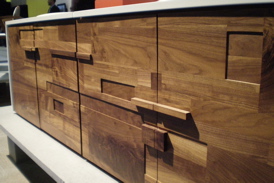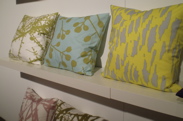ICFF: Sustainable, Green and Organic Design

On Saturday, I had a moderately awkward conversation with someone who couldn’t tell me where the teak in his pieces was sourced from. Not wanting to get into a human rights debate in the middle of the Javits Center, I politely excused myself and seethed quietly for the remainder of the afternoon — it’s amazing to me that there are still designers who aren’t morally or environmentally conscious when it comes to the production of their pieces.
On the other side of this story, however, were a myriad of companies who set out to make sustainability and environmental responsibility their number one priority. At times I was floored by the thought process evident from beginning to end in the development of such beautiful lines of fabric and furniture, and not just in the fabrication, but in delivery and end-life strategies as well. To be honest, I struggled with where to start, so I just decided to go with my five of my favorites. Stylish quasi-treehugging and photographic goodness continue after the jump.


I spent a lot of time with with Laurence Mackler and his team from Mackler+, going over his collection of architecturally-inspired furniture. The walnut, cherry and marble used throughout the series are sourced responsibly and the mosaics in his dressers and shoe bench (which is absolutely superb, especially for a shoe fiend like myself) are created of remnant material from lumber yards as well as other pieces they build. The particle board and veneers used in their design and build studio is formaldehyde-free, which is far less harmful and toxic to both workers and consumers. When I asked Laurence about the end-life of his products, he simply stated “I tell everyone who buys my pieces that if they’re ever done, I’ll buy it back from them.” Not necessarily a traditional strategy when it comes to recycling, but definitely a great example of a designer standing up behind the quality and workmanship of his products.


Ecosystems is line of commercial contract furniture dedicated to environmental culpability from beginning to end, from the materials used, local production points, shipping and recycling — they’ll actually take back and repurpose the materials after the client has no further use for the piece. The result is a decidedly more modern, fresh take on institutionally-focused furniture.


K Studio‘s latest line of home accessories crafted from sustainable materials (organic cotton and hemp) are splendidly maudlin. The graphic of the little girl crying made me want to pick her up and hug her.



Unison‘s gorgeous organic flannel and cotton soft furnishings are screenprinted with abstact floral and other graphics to bring warmth and sophistication to a sometimes overly-femme market. The bedding, in particular, made me just want to climb right in — which I imagine as a textile designer, is exactly the reaction one would intend to inspire.



Molo‘s presence around the fair was more than prominent, as they provided the softwalls and seating around the ICFF theatre, which hosted various programs and presentations for the duration of the event. Molo create both paper and textile versions of their “Soft” series, the former being used extensively throughout the fair and also being easily recyclable; not that they would have needed, to, mind you — I’m sure they could have easily given them away to the hundreds of people entranced by their fantastic wares.
